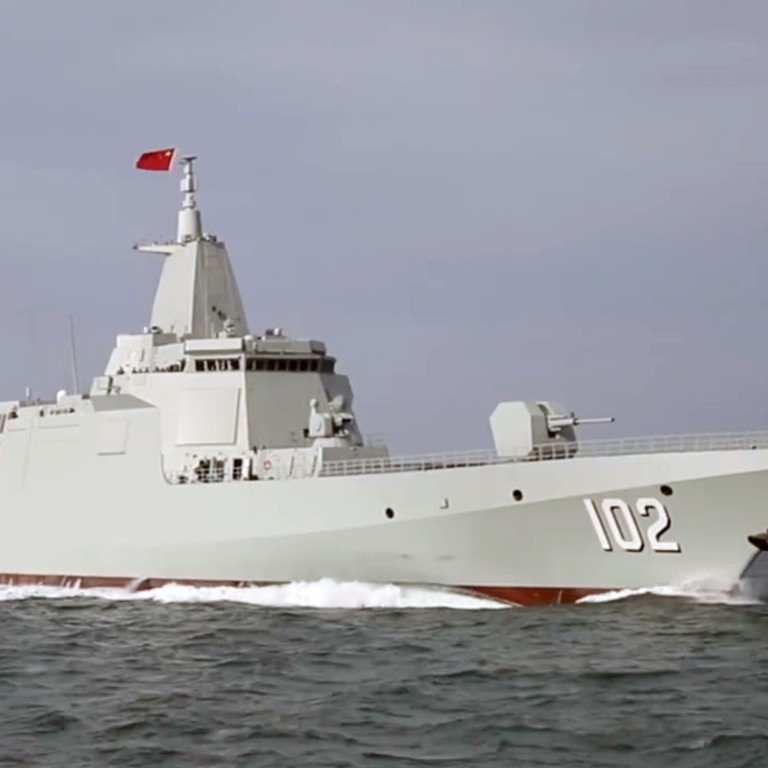
China gathers most powerful destroyers as US carrier group holds exercise off Korean peninsula
- Four of the country’s most advanced Type 055 destroyers have been operating in the Yellow Sea near their home base
- Meanwhile, US and Japanese forces conducted a training exercise following the most recent North Korean missile test
Chinese social media outlets, including the Weibo account Eagle Eye on Military Vision, published pictures of the four ships at sea, while HI Sutton, an analyst at US Naval Defence Intelligence News, identified them as four Chinese Type 055 Renhai-class guided-missile destroyers in waters near Qingdao, the headquarters of the North Sea Fleet.
The Type 055 is regarded as the second-most powerful destroyer after the US Navy’s Zumwalt-class stealth ship.
Zhou Chenming, a researcher from the Yuan Wang military science and technology think tank in Beijing, said the four Type 055 destroyers had been accompanying the country’s two aircraft carriers, the Liaoning and Shandong, as they returned to Dalian shipyard in Liaoning for maintenance.
“There is not any formal military exercise for the four ships, because a formal naval flotilla should be composed of different types of warships,” Zhou said.
The four Type 055 destroyers, Nanchang, Lhasa, Anshan and Wuxi, have been commissioned in the past two years
China has built eight Type 055 destroyers in total, six of which have already entered service.
The display of four Type 055 destroyers and the joint naval drill between the USS Abraham Lincoln aircraft carrier strike group and Japan Maritime Self-Defence Force, also coincides with North Korea’s celebrations of the 110th anniversary of the birth of its founding father Kim Il-sung on Friday, a date known as the “Day of the Sun”.
Mainland shipbuilding for Taiwan firm ‘likely aiding PLA Navy build-up’
Last month the carrier conducted another exercise in the Yellow Sea, in what the Pentagon said was a demonstration in response to North Korea’s missile launches.
Zhang Liangui, professor of international strategic research at the Central Party School, said: “North Korea is threatening to resume its long-range missile development and nuclear tests, which it once announced would stop.
“Pyongyang is afraid that the world will forget it amid the prolonged Ukraine due to the dilemma of ceasefire negotiation between Moscow and Kyiv.”
Collin Koh, a research fellow with the S Rajaratnam School of International Studies at Nanyang Technological University in Singapore, said the US-Japan joint naval drill aimed to deter potential provocations from North Korea and reassure US allies.

“[The] exercise is likely aimed at impressing upon North Korea that allied cohesion – at least between Japan and the US – remains solid, while they’re putting efforts to convince South Korea to step up trilateral military cooperation.”
A spokesman for the US 7th Fleet told the US military newspaper Stars and Stripes the carrier group was conducting “routine bilateral operations” with Japan’s Maritime Self-Defence Force.
“Our training enhances the credibility of conventional deterrence by demonstrating the strength of our bilateral partnerships,” 7th Fleet spokesman Lt Mark Langford said.
Operations like this “reassure our allies and partners of the US commitment to maintaining a free and open Indo-Pacific”, he said.
Zhou said the North was facing a major food security threat as a result of sanctions from the West and the impact of the Ukraine war on global food supplies.
“The North is going to use missile and nuclear tests to earn more bargaining chips in denuclearisation talks, pushing the US to revise its sanctions, to get more food and fuel assistance from the outside world,” he said.

